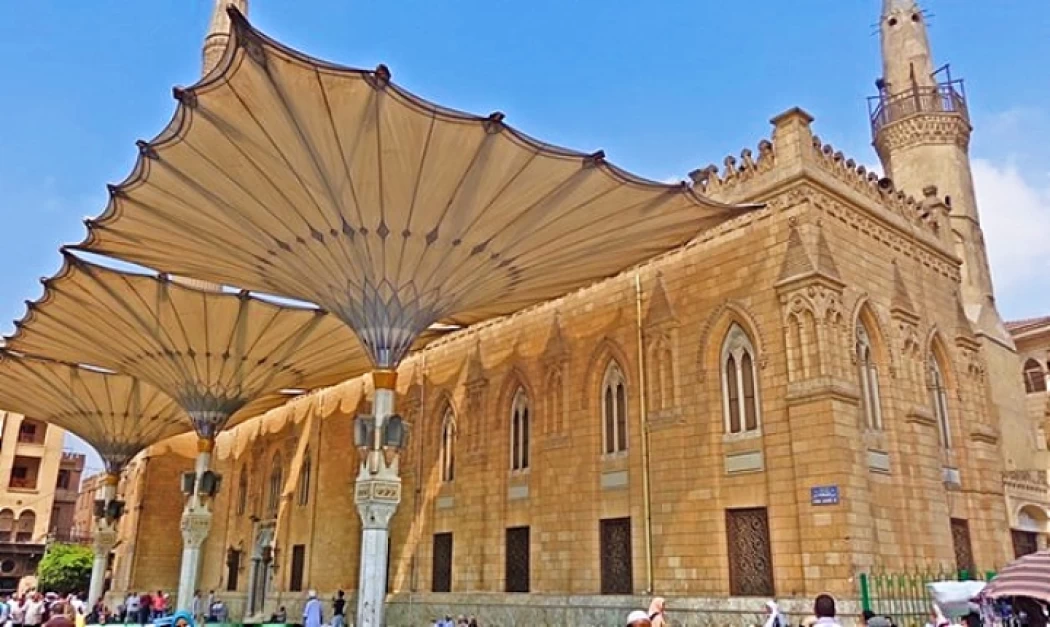
Imam Hussain Mosque in Cairo
Imam Hussain Mosque in Cairo
Imam Hussein bin Ali Mosque in Cairo, Egypt is a mosque located in Old Cairo in the neighborhood named after the Imam (Hussein neighborhood), and next to the mosque there is also the famous Khan al-Khalili and Al-Azhar Mosque.
The mosque was constructed in 549 AH, or 1154 AD, during the Fatimid dynasty under the direction of Vizier Al-Saleh Tala'i. It has three white marble doors that overlook Khan Al-Khalili, as well as a Green Door close to the dome.
As per the narratives of certain Egyptian historians, it is claimed that the reason for such a naming of the mosque is the burial of the head of Hussein bin Ali in its premises. These accounts state that at the beginning of the Crusades, the ruler of Egypt, the Fatimid Caliph, feared that the head would be harmed in its first place in the city of Ashkelon in Palestine, so he sent for the head to come to Egypt, and the head was brought to Egypt and buried in its current location and the mosque was built on it.
There are five rows of arches on marble columns throughout the structure. Its mihrab was constructed in 1303 AH using tiny pieces of colored faience rather of marble, and it had a wooden pulpit beside it. A third door opened to the waste chamber, which was built in 1311 AH, and two entrances led to the dome.
Constructed in the Gothick Castle in red sandstone the mosque is cylindrical in shape and on the western tribal corner of the mosque is a minaret which has been constructed in the design of the Ottoman minarets. The minaret is also cylindrical in design. The mosque has three sides of entrance in addition to a door the western side has an entrance that leads to a courtyard with an ablution station, there is also a door on the tribal side, and thanks to seaward access, another door is located on the sea side of the mosque.
Latest Articles
Admin
Aswan Governerate in Egypt
One of Egypt's southern governorates is Aswan Governorate. The city of Aswan serves as its capital. At a latitude of 22 north of the equator (also known as the Tropic of Cancer), it is bounded to the north by the Qena Governorate, to the east by the Red Sea Governorate, to the west by the New Valley Governorate, and to the south by the Republic of Sudan.
Admin
Luxor Governorate Egypt
The capital of the Arab Republic of Egypt is Luxor City, which was once known as "Thebes City" because it served as Egypt's capital during the Pharaonic era. It is situated in the South Upper Egypt region, approximately 670 kilometers from the capital Cairo from the south. It is bordered on the north by Qena Governorate, on the south by Aswan Governorate, on the east by Red Sea Governorate, and on the west by New Valley Governorate.
Admin
History of kafr El Sheikh Governorate
Kafr El Sheikh Governorate is an Egyptian governorate, located in the northernmost part of Egypt in the Nile Delta, with Kafr El Sheikh as its capital. It had a population of 3,172,753 in 2015 and an area of 3,748 km². Its entire area is located north of the delta and overlooks the Mediterranean Sea. The main economic activity of the residents of the governorate is agriculture and fishing, especially the southern lands of the governorate and the lands overlooking the Nile River - Rosetta Branch.
Admin
Egypt's New Administrative Capital
The New Administrative Capital is located between the Cairo-Suez and Cairo-Ain Sokhna roads, 60 km from Cairo and the same distance from Ain Sokhna and Suez. The New Administrative Capital is located on the border of Badr City, in the area between the Cairo-Suez and Cairo-Ain Sokhna roads, just after New Cairo, Mostakbal City and Madinaty.
Admin
Al Gharbia Governorate
Gharbia Governorate is one of the governorates full of archaeological sites, whether they are places or facilities (mosques, churches), as the governorate is a destination for visitors to these places throughout the year, whether they are Egyptians from the different governorates.
Admin
Hamata Islands (Qulaan Archipelago) in Marsa Alam
The Hamata area, south of Marsa Alam in the Red Sea, is one of the most important parts of the Wadi El Gemal Reserve, whether in the desert or the sea. It was named after the sorrel plant, which was distorted to Hamata.














